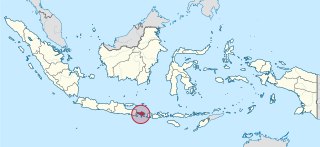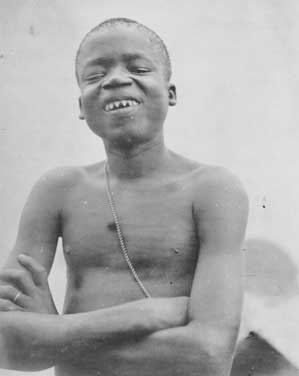
Bali is a province of Indonesia and the westernmost of the Lesser Sunda Islands. East of Java and west of Lombok, the province includes the island of Bali and a few smaller offshore islands, notably Nusa Penida, Nusa Lembongan, and Nusa Ceningan to the southeast. The provincial capital, Denpasar, is the most populous city in the Lesser Sunda Islands and the second-largest, after Makassar, in Eastern Indonesia. The upland town of Ubud in Greater Denpasar is considered Bali's cultural centre. The province is Indonesia's main tourist destination, with a significant rise in tourism since the 1980s, and becoming an Indonesian area of overtourism. Tourism-related business makes up 80% of the Bali economy.

Adolescence is a transitional stage of physical and psychological development that generally occurs during the period from puberty to adulthood. Adolescence is usually associated with the teenage years, but its physical, psychological or cultural expressions may begin earlier or end later. Puberty typically begins during preadolescence, particularly in females. Physical growth and cognitive development can extend past the teens. Age provides only a rough marker of adolescence, and scholars have not agreed upon a precise definition. Some definitions start as early as 10 and end as late 30. The World Health Organization definition officially designates an adolescent as someone between the ages of 10 and 19.

Balinese Hinduism is the form of Hinduism practised by the majority of the population of Bali. This is particularly associated with the Balinese people residing on the island, and represents a distinct form of Hindu worship incorporating local animism, ancestor worship or Pitru Paksha, and reverence for Buddhist saints or Bodhisattava.

The Balinese people are an Austronesian ethnic group native to the Indonesian island of Bali. The Balinese population of 4.2 million live mostly on the island of Bali, making up 89% of the island's population. There are also significant populations on the island of Lombok and in the easternmost regions of Java.

Rangda is the demon queen of the Leyaks in Bali, according to traditional Balinese mythology. Terrifying to behold, the child-eating Rangda leads an army of evil witches against the leader of the forces of good — Barong. The battle between Barong and Rangda is featured in a Barong dance which represents the eternal battle between good and evil.

Hinduism is the third-largest religion in Indonesia, based on civil registration data in 2022 from Ministry of Home Affairs, is practised by about 1.69% of the total population, and almost 87% of the population in Bali. Hinduism was the dominant religion in the country before the arrival of Islam and is one of the six official religions of Indonesia today. Hinduism came to Indonesia in the 1st-century through Indian traders, sailors, scholars and priests. A syncretic fusion of pre-existing Javanese folk religion, culture and Hindu ideas, that from the 6th-century also synthesized Buddhist ideas as well, evolved as the Indonesian version of Hinduism. These ideas continued to develop during the Srivijaya and Majapahit empires. About 1400 CE, these kingdoms were introduced to Islam from coast-based Muslim traders, and thereafter Hinduism, which was previously the dominant religion in the region, mostly vanished from many of the islands of Indonesia.

In orthodontics, a malocclusion is a misalignment or incorrect relation between the teeth of the upper and lower dental arches when they approach each other as the jaws close. The English-language term dates from 1864; Edward Angle (1855–1930), the "father of modern orthodontics", popularised it. The word "malocclusion" derives from occlusion, and refers to the manner in which opposing teeth meet.

Nyepi is a Balinese "Day of Silence" that is commemorated every Isakawarsa according to the Balinese calendar. It is a Balinese celebration mainly celebrated in Bali, Indonesia.
Gender variance or gender nonconformity is behavior or gender expression by an individual that does not match masculine or feminine gender norms. A gender-nonconforming person may be variant in their gender identity, being transgender or non-binary, or they may be cisgender. In the case of transgender people, they may be perceived, or perceive themselves as, gender-nonconforming before transitioning, but might not be perceived as such after transitioning. Transgender adults who appear gender-nonconforming after transition are more likely to experience discrimination.
Teenage rebellion is a part of social development in adolescents in order for them to develop an identity independent from their parents or family and a capacity for independent decision-making. They may experiment with different roles, behaviors, and ideologies as part of this process of developing an identity. Teenage rebellion has been recognized within psychology as a set of behavioral traits that supersede class, culture, or race; some psychologists, however, have disputed the universality of the phenomenon. According to Terror Management Theory, the child's allegiance to parental authority and worldviews can weaken after the discovery that parents, like themselves and everyone else, are mortal. This realization creates an unconscious need for security that is broader than what the parents alone provide. This can lead to new cultural allegiances, in the search for a more enduring sense of meaning. Teenagers seek to perceive themselves a valued contributor to aspects of culture that more convincingly outlive or transcend the mortal individual's lifespan. However, since the parents also instill their cultural beliefs onto the child, if the child does not come to associate their parents' mortality with their cultural beliefs, the chances of rebellion decrease.

A parenting style is a pattern of behaviors, attitudes, and approaches that a parent uses when interacting with and raising their child. The study of parenting styles is based on the idea that parents differ in their patterns of parenting and that these patterns can have a significant impact on their children's development and well-being. Parenting styles are distinct from specific parenting practices, since they represent broader patterns of practices and attitudes that create an emotional climate for the child. Parenting styles also encompass the ways in which parents respond to and make demands on their children.
Adolescent sexuality is a stage of human development in which adolescents experience and explore sexual feelings. Interest in sexuality intensifies during the onset of puberty, and sexuality is often a vital aspect of teenagers' lives. Sexual interest may be expressed in a number of ways, such as flirting, kissing, masturbation, or having sex with a partner. Sexual interest among adolescents, as among adults, can vary greatly, and is influenced by cultural norms and mores, sex education, as well as comprehensive sexuality education provided, sexual orientation, and social controls such as age-of-consent laws.

Human tooth sharpening is the practice of manually sharpening the teeth, usually the front incisors. Filed teeth are customary in various cultures. Many remojadas figurines found in parts of Mexico have filed teeth and it is believed to have been common practice in their culture. The Zappo Zap people of the Democratic Republic of Congo are believed to have filed their teeth.
Child-to-parent violence (CPV), also recognized as abuse of parents by their children, constitutes a manifestation of domestic violence characterized by the infliction of maltreatment upon parents. This mistreatment commonly manifests in verbal or physical forms.
Bullying suicide are considered together when the cause of suicide is attributable to the victim having been bullied, either in person or via social media. Writers Neil Marr and Tim Field wrote about it in their 2001 book Bullycide: Death at Playtime.

Gandrung is a traditional dance from Indonesia. Gandrung has many variations and is popular in Bali, Lombok, and Eastern Java among the Balinese, Sasak, and Javanese. The most popular variation is gandrung from the Banyuwangi region in the eastern peninsula of Java, so much so that the city is often referred to as Kota Gandrung or "the city of gandrung". Originally a ritual dance dedicated to the goddess of rice and fertility, Dewi Sri, it is currently performed as a social dance of courtship and love in communal and social events, or as a tourist attraction. Gandrung Sewu Festival is held at Banyuwangi annually.

Negara: The Theatre State in Nineteenth-Century Bali is a 1980 book written by anthropologist Clifford Geertz. Geertz argues that the pre-colonial Balinese state was not a "hydraulic bureaucracy" nor an oriental despotism, but rather, an organized spectacle. The noble rulers of the island were less interested in administering the lives of the Balinese than in dramatizing their rank and hence political superiority through large public rituals and ceremonies. These cultural processes did not support the state, he argues, but were the state.
It is perhaps most clear in what was, after all, the master image of political life: kingship. The whole of the negara - court life, the traditions that organized it, the extractions that supported it, the privileges that accompanied it - was essentially directed toward defining what power was; and what power was what kings were. Particular kings came and went, 'poor passing facts' anonymized in titles, immobilized in ritual, and annihilated in bonfires. But what they represented, the model-and-copy conception of order, remained unaltered, at least over the period we know much about. The driving aim of higher politics was to construct a state by constructing a king. The more consummate the king, the more exemplary the centre. The more exemplary the centre, the more actual the realm.

Balinese cuisine is a cuisine tradition of Balinese people from the volcanic island of Bali. Using a variety of spices, blended with the fresh vegetables, meat and fish. Part of Indonesian cuisine, it demonstrates indigenous traditions, as well as influences from other Indonesian regional cuisine, Chinese and Indian. The island's inhabitants are predominantly Hindu and culinary traditions are somewhat distinct with the rest of Indonesia, with festivals and religious celebrations including many special foods prepared as the offerings for the deities, as well as other dishes consumed communally during the celebrations.

A wantilan is a Balinese pavilion (bale) used for activities involving large crowds. A wantilan is the largest type of bale in Balinese architecture. A wantilan is basically a large wall-less hall placed under a large multi-tiered roof. A wantilan as a public building is usually located at a village's main square or main junction and functions as an open hall to hold large community activities such as meeting halls or a public musical gamelan performance. A wantilan is also a religious building, an integral part of Balinese temples used to hold the Balinese cockfighting ceremony.

Barong dance is a style of traditional Balinese from Bali, Indonesia. The dance demonstrates about the mythological depiction of animals that have supernatural powers and the ability to protect humans. Barong is the king of the spirits, leader of the hosts of good, and the enemy of Rangda, the demon queen and mother of all spirit guarders in the mythological traditions of Bali. The Barong dance featured a battle between Barong and Rangda to represent the eternal battle between good and evil.















